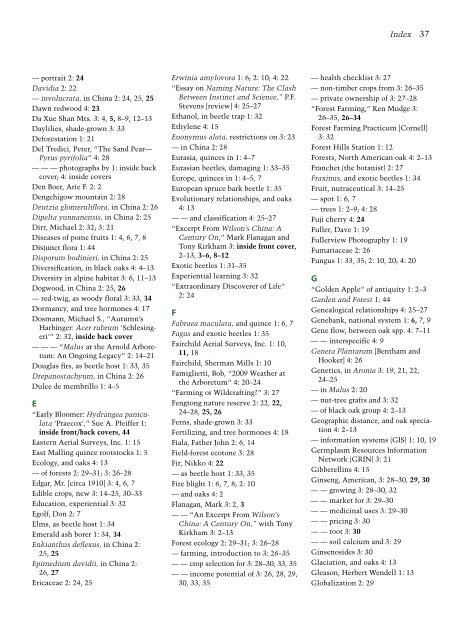The Magazine of the Arnold Arboretum - Arnoldia - Harvard University
The Magazine of the Arnold Arboretum - Arnoldia - Harvard University
The Magazine of the Arnold Arboretum - Arnoldia - Harvard University
Create successful ePaper yourself
Turn your PDF publications into a flip-book with our unique Google optimized e-Paper software.
Index 37<br />
— portrait 2: 24<br />
Davidia 2: 22<br />
— involucrata, in China 2: 24, 25, 25<br />
Dawn redwood 4: 23<br />
Da Xue Shan Mts. 3: 4, 5, 8–9, 12–13<br />
Daylilies, shade-grown 3: 33<br />
Deforestation 1: 21<br />
Del Tredici, Peter, “<strong>The</strong> Sand Pear—<br />
Pyrus pyrifolia” 4: 28<br />
— — — photographs by 1: inside back<br />
cover; 4: inside covers<br />
Den Boer, Arie F. 2: 2<br />
Dengchigow mountain 2: 28<br />
Deutzia glomeruliflora, in China 2: 26<br />
Dipelta yunnanensis, in China 2: 25<br />
Dirr, Michael 2: 32; 3: 21<br />
Diseases <strong>of</strong> pome fruits 1: 4, 6, 7, 8<br />
Disjunct flora 1: 44<br />
Disporum bodinieri, in China 2: 25<br />
Diversification, in black oaks 4: 4–13<br />
Diversity in alpine habitat 3: 6, 11–13<br />
Dogwood, in China 2: 25, 26<br />
— red-twig, as woody floral 3: 33, 34<br />
Dormancy, and tree hormones 4: 17<br />
Dosmann, Michael S., “Autumn’s<br />
Harbinger: Acer rubrum ‘Schlesingeri’”<br />
2: 32, inside back cover<br />
— — — “Malus at <strong>the</strong> <strong>Arnold</strong> <strong>Arboretum</strong>:<br />
An Ongoing Legacy” 2: 14–21<br />
Douglas firs, as beetle host 1: 33, 35<br />
Drepanostachyum, in China 2: 26<br />
Dulce de membrillo 1: 4–5<br />
E<br />
“Early Bloomer: Hydrangea paniculata<br />
‘Praecox’,” Sue A. Pfeiffer 1:<br />
inside front/back covers, 44<br />
Eastern Aerial Surveys, Inc. 1: 15<br />
East Malling quince rootstocks 1: 5<br />
Ecology, and oaks 4: 13<br />
— <strong>of</strong> forests 2: 29–31; 3: 26–28<br />
Edgar, Mr. [circa 1910] 3: 4, 6, 7<br />
Edible crops, new 3: 14–25, 30–33<br />
Education, experiential 3: 32<br />
Egolf, Don 2: 7<br />
Elms, as beetle host 1: 34<br />
Emerald ash borer 1: 34, 34<br />
Enkianthus deflexus, in China 2:<br />
25, 25<br />
Epimedium davidii, in China 2:<br />
26, 27<br />
Ericaceae 2: 24, 25<br />
Erwinia amylovora 1: 6; 2: 10; 4: 22<br />
“Essay on Naming Nature: <strong>The</strong> Clash<br />
Between Instinct and Science,” P.F.<br />
Stevens [review] 4: 25–27<br />
Ethanol, in beetle trap 1: 32<br />
Ethylene 4: 15<br />
Euonymus alata, restrictions on 3: 23<br />
— in China 2: 28<br />
Eurasia, quinces in 1: 4–7<br />
Eurasian beetles, damaging 1: 33–35<br />
Europe, quinces in 1: 4–5, 7<br />
European spruce bark beetle 1: 35<br />
Evolutionary relationships, and oaks<br />
4: 13<br />
— — and classification 4: 25–27<br />
“Excerpt From Wilson’s China: A<br />
Century On,” Mark Flanagan and<br />
Tony Kirkham 3: inside front cover,<br />
2–13, 3–6, 8–12<br />
Exotic beetles 1: 31–35<br />
Experiential learning 3: 32<br />
“Extraordinary Discoverer <strong>of</strong> Life”<br />
2: 24<br />
F<br />
Fabraea maculata, and quince 1: 6, 7<br />
Fagus and exotic beetles 1: 35<br />
Fairchild Aerial Surveys, Inc. 1: 10,<br />
11, 18<br />
Fairchild, Sherman Mills 1: 10<br />
Famiglietti, Bob, “2009 Wea<strong>the</strong>r at<br />
<strong>the</strong> <strong>Arboretum</strong>” 4: 20–24<br />
“Farming or Wildcrafting?” 3: 27<br />
Fengtong nature reserve 2: 22, 22,<br />
24–28, 25, 26<br />
Ferns, shade-grown 3: 33<br />
Fertilizing, and tree hormones 4: 18<br />
Fiala, Fa<strong>the</strong>r John 2: 6, 14<br />
Field-forest ecotone 3: 28<br />
Fir, Nikko 4: 22<br />
— as beetle host 1: 33, 35<br />
Fire blight 1: 6, 7, 8; 2: 10<br />
— and oaks 4: 2<br />
Flanagan, Mark 3: 2, 3<br />
— — “An Excerpt From Wilson’s<br />
China: A Century On,” with Tony<br />
Kirkham 3: 2–13<br />
Forest ecology 2: 29–31; 3: 26–28<br />
— farming, introduction to 3: 26–35<br />
— — crop selection for 3: 28–30, 33, 35<br />
— — income potential <strong>of</strong> 3: 26, 28, 29,<br />
30, 33, 35<br />
— health checklist 3: 27<br />
— non-timber crops from 3: 26–35<br />
— private ownership <strong>of</strong> 3: 27–28<br />
“Forest Farming,” Ken Mudge 3:<br />
26–35, 26–34<br />
Forest Farming Practicum [Cornell]<br />
3: 32<br />
Forest Hills Station 1: 12<br />
Forests, North American oak 4: 2–13<br />
Franchet (<strong>the</strong> botanist) 2: 27<br />
Fraxinus, and exotic beetles 1: 34<br />
Fruit, nutraceutical 3: 14–25<br />
— spot 1: 6, 7<br />
— trees 1: 2–9; 4: 28<br />
Fuji cherry 4: 24<br />
Fuller, Dave 1: 19<br />
Fullerview Photography 1: 19<br />
Fumariaceae 2: 26<br />
Fungus 1: 33, 35; 2: 10, 20; 4: 20<br />
G<br />
“Golden Apple” <strong>of</strong> antiquity 1: 2–3<br />
Garden and Forest 1: 44<br />
Genealogical relationships 4: 25–27<br />
Genebank, national system 1: 6, 7, 9<br />
Gene flow, between oak spp. 4: 7–11<br />
— — interspecific 4: 9<br />
Genera Plantarum [Bentham and<br />
Hooker] 4: 26<br />
Genetics, in Aronia 3: 19, 21, 22,<br />
24–25<br />
— in Malus 2: 20<br />
— nut-tree grafts and 3: 32<br />
— <strong>of</strong> black oak group 4: 2–13<br />
Geographic distance, and oak speciation<br />
4: 2–13<br />
— information systems (GIS) 1: 10, 19<br />
Germplasm Resources Information<br />
Network (GRIN) 3: 21<br />
Gibberellins 4: 15<br />
Ginseng, American, 3: 28–30, 29, 30<br />
— — growing 3: 28–30, 32<br />
— — market for 3: 29–30<br />
— — medicinal uses 3: 29–30<br />
— — pricing 3: 30<br />
— — root 3: 30<br />
— — soil calcium and 3: 29<br />
Ginsenosides 3: 30<br />
Glaciation, and oaks 4: 13<br />
Gleason, Herbert Wendell 1: 13<br />
Globalization 2: 29

















